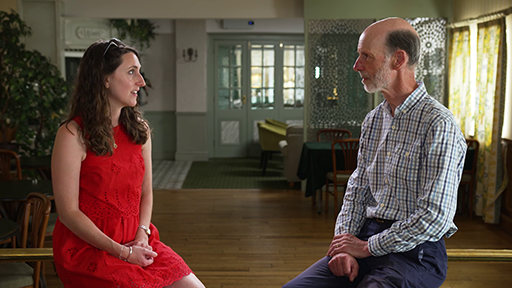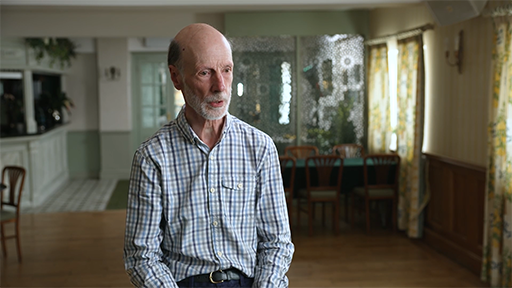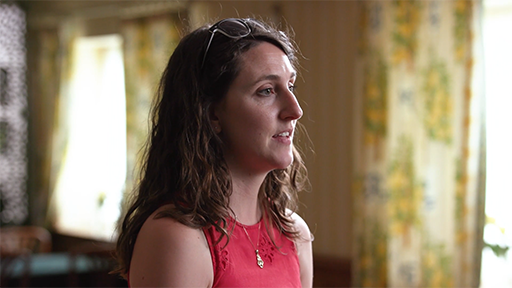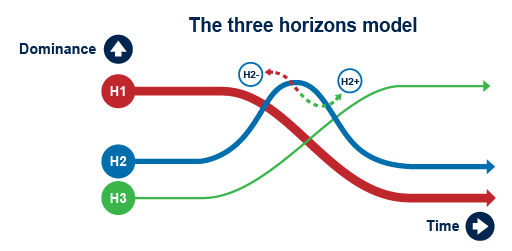5.1 Three Horizons
The International Futures Forum’s ‘Three Horizons model’ [Tip: hold Ctrl and click a link to open it in a new tab. (Hide tip)] is a simple way to encourage conversations about challenges in the present, aspirations for the future and the innovation and solutions that maybe required to address these.
It is an approach that has been adopted and adapted by the Future Generations Commissioner for Wales, to create a toolkit for public bodies to use to assist with their long term futures planning.
In Video 10, Bill Sharpe (Founding Partner – Future Stewards, Independent Researcher in Science, Technology and Society) and Dr Louisa Petchey (Senior Policy Specialist – Public Health Wales) discuss how the Three Horizons approach was used to develop an approach to futures thinking.
As you watch the video, think about some of the earlier sections of the course and reflect on how comfortable you feel about futures planning now.

Transcript: Video 10 Using the Three Horizons for futures planning
The Three Horizons approach can be used to consider the issue, how it might change over time and the different perspective of stakeholders. This is shown in Figure 20 and Table 7.
| What | How | Stakeholder perspectives | |
|---|---|---|---|
Horizon 1 Business as usual – the current situation |
The need for the current situation to change | Right now, current trends and issues | Power holders |
Horizon 2 Activities and innovations for doing things differently |
Ideas for how to get from where we are now | Emerging trends | Innovators |
Horizon 3 Long-term solutions and new ways of doing business as usual |
A vision for the future | Trends that might dominate the future, competing visions | Visionary |
In video 11 below Bill Sharpe explains the Three Horizons approach.

Transcript: Video 11 Overview of the Three Horizons approach
In the video Bill Sharpe explained that the Three Horizons approach draws attention to the three horizons as existing in the present moment, from which we can gather evidence about the future from the present, in order to consider different possible futures.
Each horizon is designed to allow you to explore the different possibilities.
H1 – The First Horizon...
… is the dominant system at present. It represents ‘business as usual’. We rely on these systems being stable and reliable but as the world changes, so aspects of business as usual begin to feel out of place or no longer fit for purpose. Eventually business as usual will be superseded by new ways of doing things.
H3 – The Third Horizon...
…emerges as the long term successor to business-as-usual. It grows from fringe activity in the present that introduces completely new ways of doing things but which turn out to be much better fitted to the world that is emerging than the dominant H1 systems. We call these early manifestations ‘pockets of the future in the present.’
H2 – The Second Horizon...
…is a pattern of transition activities and innovations, people trying things out in response to the ways in which the landscape is changing. Some of these innovations will be taken up by H1 systems to prolong their life while some will pave the way for the emergence of the radically different H3 systems.
All horizons should be looked at together to think about the changes between them overtime.
Activity 14 Consider how you can use the Three Horizons approach
1. Watch the video in which Dr Louisa Petchey, explains the Three Horizons approach and how it can be used by public bodies to assist with long term planning.

Transcript: Video 12 Using Three Horizons for long term planning
2. Review the ‘Three horizons: A toolkit to help you think and plan for the long-term’ (Petchey, n.d.) and plan a workshop (see p. 11 of the toolkit) with your colleagues outside the time allocated to studying this course. Familiarise yourself with the model and focus on an issue/problem you wish to address together.
You may wish to make notes on how you will approach this, below.
If you wish to develop your understanding of the Three Horizons approach further, the International Futures Forum and H3 Unit provide access to guidance on using the approach and resources that are freely available for use.
- Three Horizons (iffpraxis.com)
- Three Horizons (h3uni.org)

